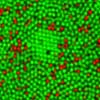|
Nucleation Crystallisation is among the most common everyday physical phenomena. Yet in the principle material in which quantitative comparison has been made between experiment and theory hard spheres predictions of crystal nucleation rates are up to 20 orders of magnitude slower than measurements, the "second worst prediction in physics" [1]. 
This discrepancy casts doubt upon the theoretical methods concerned importance sampling which is important not only for crystallisation, because these methods are used to tackle a very wide range of problems, such as drug uptake in cells and chemical reaction pathways. While particle-resolved studies reveal in intimate detail local mechanisms of structural change, they can only access rather fast crystallisation, where there is no discrepancy [2]. However gravitational sedimentation may influence the local structure of the colloidal liquid, which we show can drastically alter crystallisation [3]. We further image nano-particles with STED "nanoscopy", whose timescales are orders of magnitude faster than the larger colloids: thus by "rescaling time", we access new dynamical regimes where the massive discrepancy is found.
|